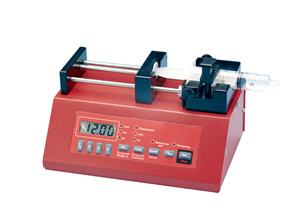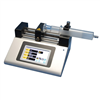

AL-1050
Aladdin SyringeONE:80 High Flow Programmable Syringe Pump
- Overview
- Specifications
- Accessories
- Citations
- Related Products
Overview

There are 1 images available to view - click to enlarge and scroll through the product gallery.
AL-1050 Instruction Manual
/ Download as PDF
-
Automatic dispensing of small volumes
-
Very precise, reproducible flow rate control
-
Displays total volume dispensed in mL or µL units
-
Selectable infusion/withdrawal rate units (mL/hr, µL/hr, mL/min, µL/min)
-
Infusion rate can be changed while pumping
-
Program pump via keypad or from a computer
-
Highly controllable – program sequences without a computer (holds up to 41 programming phases)
-
Network, control, and monitor up to 100 pumps with one computer
-
Hands-free operation with optional foot switch ADPT2
-
Motor stall detection
| Channels | 1 |
| Type | Infusion / Withdrawal |
| Flow Range | 0.004 µL/hr (0.5 µL syringe) to 907 mL/min (140 mL syringe) |
| Dispensing Accuracy | ±1% |
| Syringe Sizes Accepted | 0.5 µL to 60 mL or 140 mL partially filled |
| Linear Force | 20 lb at low speed; 10 lb at maximum speed |
To meet the demands of a busy lab Aladdin Pumps offer exceptional value providing versatility and reliability for accurately dispensing media down into the nanoliter range.
The Aladdin AL-1050 is a programmable single channel infusion / withdrawal syringe pump. It has a metal casing to provide stability, ensuring less vibration is transferred to the syringes. Setup is easy using the pumps keypad or via a computer with optional PC to pump cable (GN-PC7 or GN-PC25).
The Aladdin AL-1050 can run complex programs with up to 41 pumping phases can be set to change pumping rates; set dispensing volumes; insert pauses; control and respond to external signals; sound the buzzer. (For Linear/Gradient programs use AL-1050X)
Example flow rates
| Syringe Size | Maximum Rate | Minimum Rate |
| 0.5 µL | 4434 µL/hr | 0.004 µL/hr |
| 1 mL | 13.87 mL/min | 6.35 µL/hr |
| 3 mL | 46.3 mL/min | 21.2 µL/hr |
| 5 mL | 90.31 mL/min | 41.35 µL/hr |
| 10 mL | 1308.8 mL/min | 59.89 µL/hr |
| 20 mL | 227.9 mL/min | 104.4 µL/hr |
| 30 mL | 292.8 mL/min | 134.1 µL/hr |
| 60 mL | 444.1 mL/min | 203.4 µL/hr |
| 140 mL | 907.1 mL/min | 415.0 µL/hr |
Specifications
| SYRINGE SIZES | up to 60 mL (140 mL partially filled) |
| NUMBER OF SYRINGES | 1 |
| MOTOR TYPE | Step Motor, 1/8 to 1/2 step modes |
| STEPS PER REVOLUTIONS | 200 |
| STEPPING (max. min.) | 1.8520833 µm to 7.4083333 µm depending on motor speed |
| MOTOR TO DRIVE SCREW RATIO | 28/15 |
| SPEED(max./min.) | 80.01 cm/min / 0.0366 cm/hr |
| PUMPING RATES | 444.1 mL/min with 60mL syringe, to 6.35 µL/hr with 1mL syringe |
| MAXIMUM FORCE | 20 lb at min. speed, 10 lb at max. speed |
| NUMBER OF PROGRAM PHASES | 41 |
| RS-232 PUMP NETWORK | 100 pumps maximum |
| POWER SUPPLY | Wall adapter 12V DC @ 1000mA |
| DIMENSIONS | 22.9 x 14.6 x 11.4 cm (8.75 x 5.75 x 4.5 in.) |
| WEIGHT | 1.6 kg (3.6 lb) |
Accessories
Citations
Birngruber, T., & Ghosh, A. (2013). Cerebral open flow microperfusion: A new in vivo technique for continuous measurement of substance transport across the intact blood–brain barrier. Clinical and …. Retrieved from https://onlinelibrary.wiley.com/doi/10.1111/1440-1681.12174/full
Ferreira, D., Reis, R., & Azevedo, H. (2013). Peptide-based microcapsules obtained by self-assembly and microfluidics as controlled environments for cell culture. Soft Matter. Retrieved from https://pubs.rsc.org/EN/content/articlehtml/2013/sm/c3sm51189h
Herricks, T., Avril, M., Janes, J., Smith, J., & Rathod, P. (2013). Clonal Variants of Plasmodium falciparum Exhibit a Narrow Range of Rolling Velocities to Host Receptor CD36 under Dynamic Flow Conditions. Eukaryotic cell. Retrieved from https://ec.asm.org/content/12/11/1490.short
Maya, H., Vincent, M., & Nötzli, S. (2013). Increased porosity of electrospun hybrid scaffolds improved bladder tissue regeneration. … Research Part A. Retrieved from https://onlinelibrary.wiley.com/doi/10.1002/jbm.a.34889/full
Tõnurist, K., Thomberg, T., & Jänes, A. (2013). Polymorphic Behavior and Morphology of Electrospun Poly (Vinylidene Fluoride) Separator Materials for Non-Aqueous Electrolyte Based Electric Double Layer. ECS …. Retrieved from https://ecst.ecsdl.org/content/50/45/49.short
Tõnurist, K., Thomberg, T., Jänes, A., & Lust, E. (2013). Specific Performance of Electrical Double–Layer Capacitors Based on Different Separator Materials and Non–Aqueous Electrolytes. ECS Transactions. Retrieved from https://ecst.ecsdl.org/content/50/43/181.short
Zander, N., & Orlicki, J. (2013). Electrospun polycaprolactone scaffolds with tailored porosity using two approaches for enhanced cellular infiltration. Journal of Materials …. Retrieved from https://link.springer.com/article/10.1007/s10856-012-4771-7
Zhang, J., Jiang, D., & Peng, H. (2014). A pressurized filtration technique for fabricating carbon nanotube buckypaper: Structure, mechanical and conductive properties. Microporous and Mesoporous Materials. Retrieved from https://www.sciencedirect.com/science/article/pii/S1387181113005192
Zhang, J., Jiang, D., Peng, H., & Qin, F. (2013). Enhanced mechanical and electrical properties of carbon nanotube buckypaper by in situ cross-linking. Carbon. Retrieved from https://www.sciencedirect.com/science/article/pii/S000862231300568X










Request
Catalogue
Chat
Print